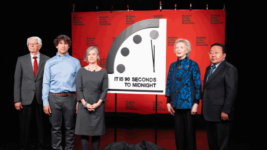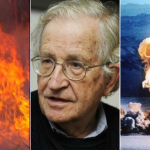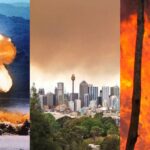Doomsday Clock at 90 Seconds to Midnight, Due to Unprecedented Dangers

This week the Doomsday Clock crept the closest it’s ever been to the end of days, as the Bulletin of the Atomic Scientists set the minute hand to 90 seconds to midnight on 24 January, with 12 am symbolising Armageddon.
In the wake of the nuclear bombing of Hiroshima, and the realisation that humanity then had the ability to wipe itself out, scientists from the Manhattan Project, the US research group that produced the first nuclear weapons, established the clock to warn of any rising existential threats.
This year the clock is set at “the closest to global catastrophe” it’s ever been, chiefly due to the war in Ukraine, with its rising threat of nuclear conflict, coupled with the escalation in climate, and a “breakdown of global norms and institutions” that can allay technological and biological threats.
However, the proposition that humanity is in pursuit of its own end is in keeping with the general trend of recent years.
In 2018, the clock crept to its then closest point, 2 minutes to midnight, and sat there for two years, symbolising the dual threats of climate and nuclear annihilation, whilst the last three years have seen it set at 100 seconds, with the addition of an online “undercutting of rational discourse”.
A minute and a half
Bulletin editor John Mecklin outlined in a release that the chief reason for mounting global insecurity is the war in Ukraine, which is undermining European security arrangements that have held since World War II and is further eroding international mechanisms designed to deal with such crises.
“And worst of all, Russia’s thinly veiled threats to use nuclear weapons remind the world that escalation of the conflict – by accident, intention, or miscalculation – is a terrible risk,” warns the author. “The possibility that the conflict could spin out of anyone’s control remains high.”
Russia’s efforts in Ukraine have included the targeting and takeover of the Zaporizhzhia nuclear power plant, Europe’s largest such facility, which has risked it being cut off from its power supply, an issue that could result in another Chernobyl-style disaster.
The Ukrainian war has also exacerbated the climate crisis as countries that were reliant on Russian oil and gas have had to diversify their sources, which has led to a significant expansion in the global gas industry, at a time when the planet needs to transition away from fossil fuels.
The dying of the light
In terms of nuclear threats, the Bulletin further lists the last remaining nuclear treaty between the US and Russia potentially caving in, expansion on the part of China, North Korea and India with Iran increasing its uranium enrichment capabilities, and the US, Russia and China modernising arsenals.
As for climate, global carbon emissions are at an all-time high, while extreme weather continues to increase around the planet, which is becoming much more clearly attributable to climate collapse. Extreme heat plagued the northern hemisphere last year, while a third of Pakistan flooded.
And the Bulletin of Atomic Scientists further warns that pandemics are likely on the rise as more diseases jump from animals to humans, and on the technology front, cyber-enabled disinformation continues to circulate as emerging surveillance technologies threaten human rights.







